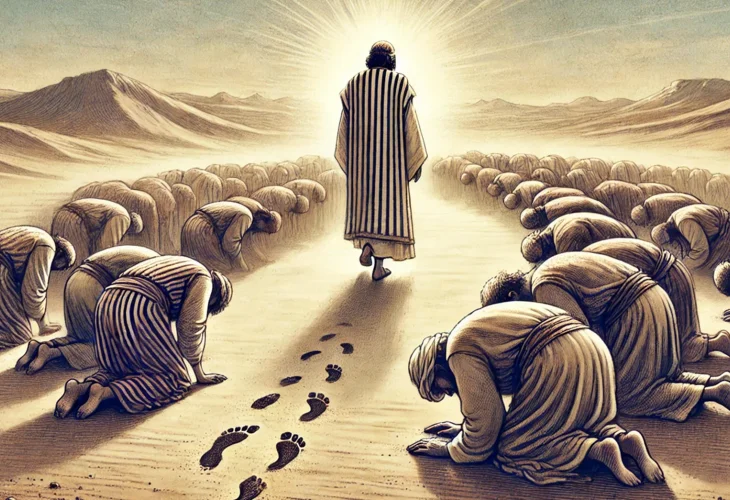Issues in the Bible
Why Did the Arabs Worship the Dust of Their Feet? The Forgotten Theology Behind Avraham’s Guests
Jewish commentators reveal how ancient “dust worship” reflected deep spiritual, philosophical, and cultural ideas — echoing even into modern thought

Avraham, when addressing his guests — whom he believed to be Arab travelers, said to them: “Let a little water be brought, and wash your feet” (Bereishit 18:4).
Rashi, quoting the Midrash, explains that “the Arabs bow down to the dust of their feet.” This is a striking statement. Could people really have worshiped the dust beneath their feet? We know of many forms of idolatry — Egyptians worshiped even dung beetles, but dust?
The Maharal: A Spiritual Philosophy Behind the Dust
The Maharal of Prague interprets this as a sign of a deeply philosophical belief among the ancient Arabs.
They understood, says the Maharal, that God is utterly transcendent, too exalted for humans to approach directly.
Therefore, they sought a spiritual intermediary — the lowest, humblest element of creation, through which they could begin their connection to the divine realm.
Dust, being the lowest and most material substance, symbolized this idea. Thus, the “angel of dust” — the spiritual force governing the dust, became their point of contact with the spiritual world.
Through this humble intermediary, they believed they could ascend gradually toward higher spiritual levels.
In a second explanation, the Maharal links this to their nomadic way of life. As wanderers whose lives depended on the success of their journeys, they worshiped the angel of the roads — the spiritual force of travel and movement. Dust, constantly raised and carried along the desert paths, symbolized these journeys. Just as idolaters of other nations worshiped animals as symbols of divine powers, these desert dwellers bowed to the dust as a symbol of the spiritual power guiding their travels.
Early Scientific and Humanistic Worldviews
While the Maharal still sees this as a sophisticated form of idolatry, the Re’em and Yefeh To’ar offer radical, almost modern interpretations.
The Re’em views “worship of the dust” as an early expression of scientific materialism — a kind of proto-atheism. He argues that the ancient Arabs did not actually worship the dust as a god, but rather saw matter itself as the basis of all existence. This, he suggests, was a primitive form of the atomistic worldview — the belief that the universe consists solely of physical elements.
The Yefeh To’ar, in contrast, sees it as an early form of secular humanism. The dust on their feet, he explains, symbolized human effort and achievement — the labor of walking, traveling, and earning one’s livelihood. To him, their reverence for this dust expressed faith in human power, detached from divine authority.
In this light, “worship of the dust” foreshadowed the Industrial Revolution’s belief in progress and human capability.
The Shelah: A Cosmic Reading
The Shelah HaKadosh offers another symbolic reading: Dust represents the drying power of the sun, a form of cosmic worship.
According to him, this was a type of solar religion, venerating the celestial forces that sustain the world. This interpretation fits perfectly with the story’s setting — “in the heat of the day”, linking the worship of dust to the cosmological power of sunlight and creation.
The Rogatchover Gaon: Worship of the Elements
The Rogatchover Gaon takes a different, historical approach. He writes that pre-Islamic Arabs worshiped the natural elements, especially earth and water.
He argues that these pagan foundations were not entirely erased by Islam. He connects the crescent moon, the primary Islamic symbol, to this ancient worldview — representing the connection between the moon and the tides, and thus a symbolic continuation of water worship.
The Rogatchover’s Critique of Maimonides
This leads to one of the Rogatchover’s boldest claims: a critique of Maimonides (Rambam). The Rambam ruled (Hilchot Ma’achalot Asurot 11:7) that Muslims are not idolaters, writing: “Likewise, any gentile who does not practice idolatry, such as these Ishmaelites…”
The Rogatchover contends that this ruling was a pragmatic concession, influenced by the Rambam’s life under Islamic rule.
In his view, vestiges of pagan nature worship persisted in Islam’s symbolism and rituals.
The Historical Context
At first glance, this seems implausible, given that Islam arose as a fierce rejection of all forms of idolatry. Muhammad’s movement was a monotheistic revolution, denouncing the “age of ignorance” (al-Jāhiliyyah) and eradicating pagan practices. The Quran repeatedly condemns polytheism and calls for exclusive submission to one God.
Yet, as the historian M. Yakubovitz notes, archaeological and anthropological evidence from pre-Islamic Arabia supports some of the Rogatchover’s insights. Ancient Arabian religions featured complex nature cults, centered on the relationship between humanity, the earth, and cosmic forces. Indeed, these undercurrents may well have left symbolic traces in later traditions.

